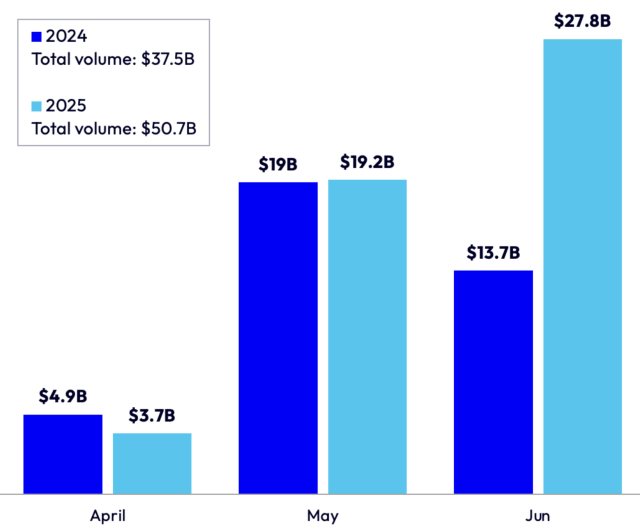The Future of Spreadsheets in Finance: A Market Practitioners’ Debate
Are spreadsheets in fact— dead? Risk.net took on this controversial question in a webinar, attempting to uncover if spreadsheets are still relevant in today’s complex financial landscape. For decades, spreadsheets have been indispensable across capital markets—from front offices to risk teams. Yet, their flexibility comes with inherent risks and limitations, making them a contentious tool in modern financial workflows.
In this on-demand webinar, the evolving role of spreadsheets in financial institutions was debated by a panel of industry practitioners, who offered insight into when and why different alternatives should be considered. Below, we share highlights of this insightful session. You can view the full webinar recording here: Are Spreadsheets Dead? A Debate Amongst Market Practitioners
Spreadsheets as a Mainstay or Obsolete Tool?
Since their debut with tools like VisiCalc in 1979, spreadsheets have been an integral component for finance professionals across investment portfolios, risk modeling, reconciliation, and data reporting. Microsoft® Excel remains a favorite due to its flexibility, widespread adoption, and accessibility. However, discussions during the webinar revealed a consensus that while spreadsheets will not be “dead” any time soon, their role in core enterprise processes may diminish.
Matteo Bedini, Product Manager at Numerix, believes that spreadsheets aren’t going to be extinct anytime soon. Their intuitive grid layout, flexibility, and efficiency for quick calculations make them indispensable for basic operations. However, their overuse in areas like data storage, computational modeling, and mission-critical workflows creates significant risks. The panelists shared experiences of errors, lack of auditability, and challenges in maintaining transparency as reasons why enterprises are seeking alternatives.
Growing Risks of Spreadsheets
Reliance on spreadsheets for business-critical functions may come at a cost—a theme that was highlighted prominently during the event. Richard Thompson of Nomura emphasized that Excel's limitations in handling collaborative workflows, data integrity, and large-scale automation pose concerns.
For example, spreadsheets are prone to manual errors, yet they are still used for vital calculations. Panelist, Ricardo Pachon from UBS Asset Management, relayed recent findings from CNBC that reported as many as 80% of all spreadsheets contain errors. He also added that spreadsheets are often misused for data storage and complex computational modeling, both of which create operational risks that extend beyond individual use.
Alternatives on the Rise
The panel explored the range of alternatives now available to streamline enterprise workflows while reducing spreadsheet reliance. Python emerged as the dominant choice for replacing spreadsheets, particularly for tasks like data analysis, visualization, and machine learning. Python’s ability to interact with a robust ecosystem of packages like pandas and Matplotlib, coupled with its collaborative coding context, makes it increasingly popular among data scientists and market practitioners.
Other alternative tools discussed in the webinar, such as Tableau and Microsoft® Power BI, are transforming data visualization, offering more dynamic and interactive insights than traditional spreadsheets. Additionally, cloud-based enterprise systems are providing scalable solutions for complex, compute-intensive tasks that were once confined to Excel.
Still other firms are adopting hybrid approaches—leveraging Excel’s familiar interface for front-end interactions while offloading data storage and heavy computations to more robust external systems. For example, Richard Thompson outlined a practical compromise Nomura implemented—a Python tool allowing users to execute Python-based scripts within Excel environments. This transition path enables firms to migrate gradual processes without disrupting workflows.
Regulatory Challenges and Compliance Perspectives
Regulators are increasingly scrutinizing spreadsheet use, primarily due to their lack of control frameworks and traceability. For example, spreadsheets often fall short of meeting rigorous governance standards required for mission-critical operations. Richard Thompson highlighted the difficulty in applying software development best practices to Excel. Version control and separation of data operations are challenging to implement, increasing regulatory exposure.
Also, proprietary dependencies on Excel may hinder compliance initiatives. While many firms routinely rely on spreadsheet formats like CSV for trade reporting, the financial space is gradually moving toward web-based reconciliation tools and enterprise analytics platforms to avoid spreadsheet pitfalls.
Spreadsheets and AI—A Symbiotic Future?
The webinar wrapped up with a discussion on artificial intelligence (AI) and its evolving role in spreadsheets. Microsoft’s integration of AI tools like Copilot into Excel aims to enhance error detection, automate tasks, and enable natural language queries.
Some panelists, like Matteo, saw AI as a way to extend Excel’s utility, while others questioned whether its true potential lies beyond spreadsheets. In finance, AI’s greatest impact is seen in advanced tools like Python, widely used by data scientists and engineers. While AI-driven features in Excel can simplify workflows, they are unlikely to transform it into a primary development platform for innovation.
That said, AI could help ease the transition from spreadsheets to more sophisticated programming environments. However, existing solutions, such as machine learning backends and Python-based APIs, already offer superior efficiency. Rather than reinventing spreadsheets, AI is more likely to serve as a complementary tool—enhancing visualization and integrating with familiar workflows.
Ultimately, while Excel remains a staple for financial modeling, the future of AI-driven finance lies in dedicated, data-native systems that go beyond the limitations of traditional grids.
The Verdict—Spreadsheets Evolving, Not Extinct
Ultimately, the panel echoed a balanced view. Spreadsheets, especially Excel, are unlikely to disappear entirely. Their flexibility and ease of use ensure their place for general use cases—back-of-the-envelope calculations, small-scale data analysis, and integration into existing workflows.
Still, in the face of growing complexity, increased regulatory demands, and the availability of advanced alternatives, spreadsheets’ dominance for enterprise-scale applications is waning. Practical compromises, such as integrating Python, are helping firms transition while maintaining operational continuity.
The webinar underscored that spreadsheets may no longer serve as the "one-size-fits-all" solution for the financial industry. Instead, their best use lies in collaboration with modern systems tailored for scalability, transparency, and compliance.
To hear the Risk.net panelists debate this topic firsthand, view the full webinar recording: Are Spreadsheets Dead? A Debate Amongst Market Practitioners


